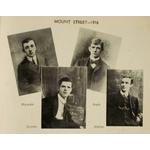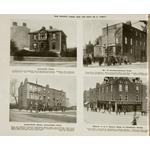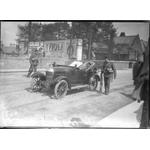Main Sites of Activity
Clanwilliam House and Mount Street Bridge
To hamper British reinforcements on their way from the port of Kingstown (Dun Laoghaire) to the city centre, Commandant de Valera posted small parties of men in buildings overlooking Northumberland Road, one of the likely routes. The buildings designated were St Stephen’s School, the parochial hall and No. 25 Northumberland Road, all at the Kingstown side of Mount Street Bridge (McKenny Bridge on map). The most important post, however, was Clanwilliam House, at the city side of the bridge, in a position commanding Northumberland Road. It was garrisoned by a party of seven men led by the section commander, George Reynolds.
On Monday afternoon, the Volunteers fired on columns of the elderly Home Defence Force styled Georgius Rex (King George) and nicknamed ‘Gorgeous Wrecks’ by Dubliners, killing or injuring a number of them. The members of the Home Defence Force were on their way home from manoeuvres; they were in uniform and carried rifles but had no ammunition, so in effect they were unarmed. There was a violent public reaction when the news spread that the Volunteers had shot these unarmed elderly men; Pearse issued an order prohibiting his forces from firing on anybody who was unarmed, whether in uniform or not.
The area was generally quiet until noon on Wednesday when a large force of military tried to force its way down Northumberland Road towards the city centre. Lieutenant Michael Malone, Volunteer James Grace and two others in No. 25 temporarily halted their progress before they were overcome by vastly superior numbers, Malone being killed in the course of the engagement. The military also cleared the school and parochial hall, but were held up by fire from Clanwilliam House at the far side of Mount Street Bridge. As there was little or no cover, successive waves of soldiers failed to make it across the bridge until eventually Clanwilliam House was set on fire. The position could have been by-passed and surrounded, but General Lowe insisted on pressing on with the frontal assault with little regard for the lives of his soldiers. His attitude probably reflected contemporary tactics on the Western Front where it was normal practice for soldiers—on both sides—to be ordered to charge virtually impregnable positions.
Three of the Volunteers, including George Reynolds, were killed, but four escaped. Over two hundred British soldiers and officers were killed or injured. Mount Street Bridge was one of the major engagements of the Rising, a monument to the bravery of the men involved on both sides—mostly very young. It was also a monument to the sheer barbarity of war, although on a relatively minor scale when set in the context of the war then raging in Europe which day in, day out destroyed thousands of men as a matter of routine.






